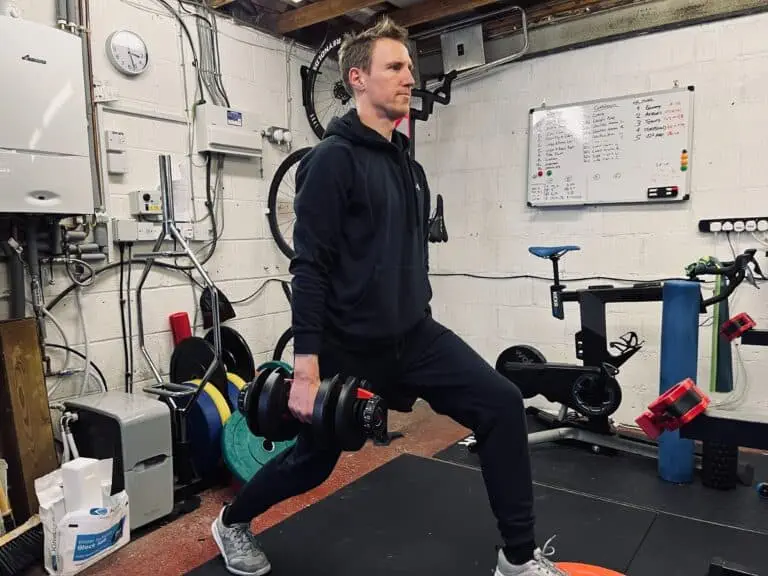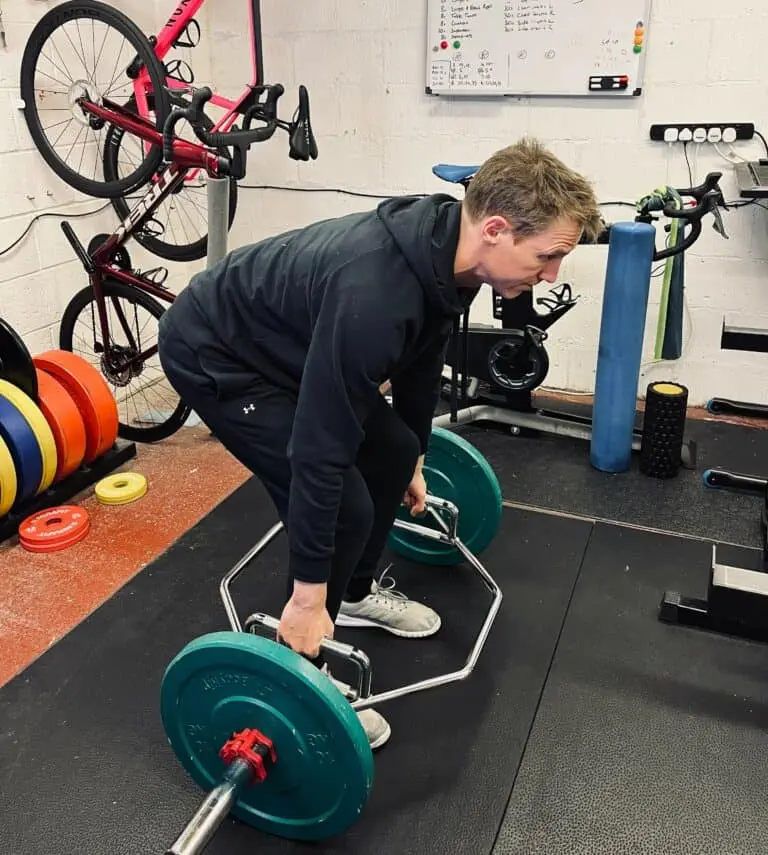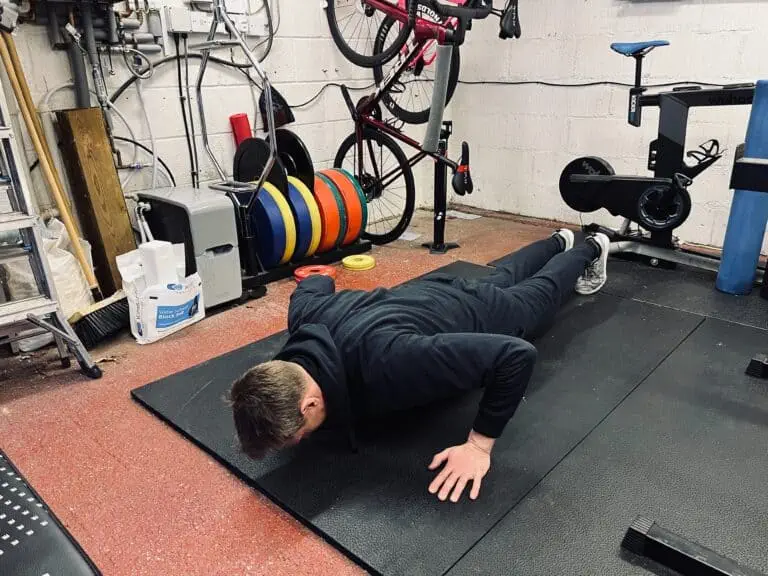How Important is Strength Training For Cycling?
Strength training has many benefits for cyclists of all ages, like increasing power and helping prevent cycling-related injuries.
While it can’t replace training on your bike, strength workouts can be another tool in your training workbox to help you excel as a cyclist.
And yet, the cycling community is split into two groups.
Some endorse weight training, and others dismiss it as an unnecessary distraction from riding.
Let’s explore this training regimen to learn more so you can make an educated decision yourself.
Key Takeaways
- The goal of strength training isn’t to look like a bodybuilder, but to build overall muscle tone and improve the muscular strength necessary for cycling.
- Strength training builds bone density, improves overall fitness, and can be a refreshing substitute for riding outdoors in the winter.
- Even if you don’t ride competitively, weight training will improve your fitness, help prevent injuries, and make longer rides feel more enjoyable.
- The four muscle movements needed for a pedal stroke are knee extension, hip extension, knee flexion, and hip flexion. Strength training targets these movements to improve one’s power and endurance.
- While weight training and resistance machines are great for strength training, alternative activities like swimming, yoga, and running can be beneficial, too.

What Strength Training is Not
Before we get too far along, I want to discuss what strength training is not. The goal isn’t to have bulging muscles like a bodybuilder. And when starting strength training exercises, you want to ease into the activity. Like cycling, you don’t just hop off the sofa and launch on a 100-mile bike ride without logging many miles beforehand.
Lastly, even if you’re not interested in competing or focusing on results-based cycling, incorporating strength training into your routine can be beneficial for general health and preventing injury. If this is you, I ask that you keep an open mind as we discuss strength training.
Strength Training Plan for You
Most cyclists associate a strength training program with going to a gym and working through various reps using free weights or resistance machines. Or you’re the type whose mantra is, “Hold my beer!” and start with massive weights only to awake the next day too sore to get out of bed, and thus end your training plan. As mentioned, the key is pacing and building up strength gradually.
While free weights and resistance machines are one aspect of strength training, there are others I’ll discuss that you can do in the privacy of your own home or in a class setting.
I’m also going to list several exercises and sports that have great strength-building benefits, so no matter where you are on the topic, there’s something that you can incorporate to improve your fitness and performance as a cyclist.

How Does Strength Training Improve Cycling Performance?
Bear with me as I share my journey on this subject. I’m in my sixties and have been cycling for over 30 years. Until recently, I was in the camp of coaches and riders who dismissed strength training as being important. Like many riders, I focused solely on cycling to improve power, speed, and endurance. I reasoned that none of my pro heroes endorsed it, so why should I?
Due to age-related injuries and possibly overtraining, I’m re-accessing weight training, albeit with some reluctance. So I have incorporated it into my winter training regimen.
While it’s too early to voice my final thoughts one way or another, I can tell that weight training is helping with joint issues caused by cycling. Will it improve my strength and power on the bike? I hope so, but time will tell.
All this is to say that I’m out of the Weight Training Is Pointless Camp and have become an advocate for strength training.
The Benefits of Strength Training
Before I get on my soapbox and preach my newfound favor with strength training, let’s look at some non-cycling reasons to consider adding it to your regimen.
Bone Density
According to the Harvard Medical School report, when adults reach 40 years of age, bone mass can decrease as much as 1% per year. Such loss leads to weaker bones, which means they are more prone to breaking. “Numerous studies have shown that strength training can play a role in slowing bone loss, and several show it can even build bone.”
Weight training targets hips, wrists, and spine that aerobic activities like cycling cannot. For one’s overall health and preventing fractures and breaks, it’s easy to see why strength training is essential.
Another sad fact about aging is that we begin to lose muscle mass. According to the National Library of Medicine, “Muscle mass decreases approximately 3–8% per decade after the age of 30 and this rate of decline is even higher after the age of 60.” While we can’t stop this deterioration, strength training helps keep it in check. To further quote from NLM: “In fact, muscle quality has been shown to improve significantly with resistance training in older people and in younger people with muscle wasting.”
If you’re young, then this information will seem irrelevant. But even young athletes can benefit from strength training, as we’ll see as we move along.
Balanced Training
Cycling only targets the legs and even those muscles are limited, since the brunt of one’s power is only in a portion of their pedal stroke. While proper spinning will impact your hamstring muscles, cycling does little to improve their power.
Strength training gives you focused workouts on crucial leg muscles like your hamstrings and those that aren’t impacted during cycling. Such training gives you a more varied workout while strengthening your surrounding muscles.
Additionally, for those over forty, strength training improves one’s balance (as in equilibrium) and brings confidence to day-to-day activities.

Winter Training Substitute
Training can be challenging for those living in regions where winter months are cold and dreary. While in my youth, I’d brave those Ohio winters and get as many miles outside as possible. Nowadays, I opt for a workout on my indoor trainer versus braving the elements and being dressed as if for a deep ocean dive. As a wise cycling buddy once counseled, “The cold temperature we’re willing to endure is directly proportional to our age.” How true he was!
But here’s my point: strength training in winter can equate to the same intensity as a long ride while also building up muscle mass. Add this to an indoor training program, and you’ll be ready to hit those spring group rides with gusto and pizazz.
Overall Fitness
I love cycling because I can sit, eat and drink regularly without stopping and coast downhill. While these are wonderful attributes of the sport, it also means that other muscle groups aren’t getting as much of a workout as your legs.
Strength training addresses the muscles cyclists often overlook because they don’t deem them essential. Again, I’m not emphasizing that one must have an upper body like a bodybuilder’s, but one neglected group of muscles key to being a better rider is your core.
A strong core gives you better bike balance, equating to superb handling skills that are imperative when riding a paceline. Taking it to another level, famed French pro, Bernard Hinault, said, “You should still be able to play the piano when riding.”
While most of us will never be as powerful or successful as Hinault, his quote is an excellent test of our core strength. Can you ride for sustained periods with your arms and hands on the bars yet capable of lifting them as if to play a keyboard? If not, some upper body and core exercises will improve this aspect.
Even if you wave this off as “not your thing,” you still need arm, core, and back strength when out of the saddle pulling the handlebars climbing a hill. And if you’re carrying some extra weight around the gut, such exercises will help slim you down, which translates into accelerating up inclines easier.

Strength Training Exercises
Whether you’re a cyclist looking to improve performance for racing, or a social rider who isn’t concerned about speed, we all need the power to turn the pedals for long periods. And who doesn’t want to feel more confident climbing or have the strength to sprint past a dog hot on your heels?
According to USA Cycling, four muscle actions come into play when pedaling a bike.
- Knee Extension. This is the action your leg does to kick a ball.
- Hip Extension. You utilize this movement when standing up from a chair.
- Knee Flexion. The direction your leg makes when kicking backward, as in the push used when ice skating.
- Hip Flexion. You use hip flexion when you lift your leg toward your chest to climb over something.
As a cyclist, the muscles used in these movements (and consequently your pedal stroke) are the quads, glutes, hamstrings, and hip flexors.
Let’s examine some exercises and methods to strengthen these muscle groups.
Weights & Resistance Machines
I can’t stress enough that if you’re not familiar with weight training or resistance machines, seek advice from a personal trainer. If you’re not careful, you can seriously damage muscles and joints. For our discussion, I’ll focus on weight machines, not free weights.
You’ll need a gym or home equipment with a leg extension machine to exercise your quads and improve knee extension. You typically sit and place your legs beneath a padded bar that you lift with both legs. What weight level you start with will depend on your fitness level. I opted for a weight I could do 3-4 sets of 10 repetitions. Since I was slowly building strength around my injured knee, I took the Goldilocks and the Three Bears approach: find one that was “just right” and not too heavy nor too light.
The seated leg press machine will strengthen the glutes, quadriceps, hamstrings, calves, and shins. This exercise replicates standing from a kneeling or seated position and improves hip extension. Again, your starting weight for the seated leg press is determined by fitness level, but you should look at being able to do several sets of repetitions without too much duress.
You’ll need to exercise on a leg curl machine for knee flexion and hip flexion. This workout targets the hamstrings (the muscles on the backside of your leg) you use when pulling through on your pedal stroke.
Upper Body
I’m also hitting strength machines that target shoulder, arm, and core muscles. While these muscles may not improve my cycling performance, they will help me feel more comfortable and confident on longer bike rides. And as a 60+ rider, I need to exercise and strengthen these muscles to avoid age-related injuries.

Strength Training Exercise Alternatives
For some cyclists, going to a gym or using weights and machines is intimidating or not appealing. As promised, here are some other exercises to explore that will improve strength and muscle tone.
Swimming
While finding a pool is a hurdle to overcome, swimming is a fantastic exercise to help cyclists. If you’re a triathlete, you’re already aware of how swimming improves your cardiovascular system, core strength, and hip flexors. I recently dove into this sport (sorry, I couldn’t resist the pun!) as another means to exercise my injured knee, and I’m beginning to feel the benefits.
Yoga/Pilates
Yoga and pilates improve strength, endurance, and flexibility, all of which will make you better as a rider and more comfortable on your bike. The benefits of yoga and pilates are that you can do them anywhere and they don’t require expensive machines. But if you’re more of the social butterfly type, look for local classes with a qualified instructor to enjoy a class and group environment.
Running
This sport is ideal for those needing a fast but effective workout to improve the cardiovascular system, build bone density, and work the upper body and core muscles. And since the only equipment needed is a quality pair of running shoes, it won’t set your budget back too much. Remember that running is a high-impact sport that, over time, can lead to knee damage or pain.
Conclusion
I hope that no matter what type of cyclist you are or what age you’re at, you’ve concluded, as I have, that strength training is vital in improving the sport of cycling.
With the variety of sports and workouts available, there’s an activity with your name on it that you’ll love doing and will make you stronger, faster, and have a more enjoyable time cycling.
Frequently Asked Questions on Cycling Strength Training
What strength training should cyclists do?
If you are looking to progress with your cycling and get fitter, increase endurance, reduce injury risk, and set new PRs, cyclists need to be doing both on-bike and off-bike exercises as part of a structured training program.
Get a qualified instructor to create a strength program to include leg, core and some upper body exercises.
Leg exercises will likely include squats, deadlifts, and lunges to target the quads, hamstrings, and glutes. We reckon it’s important to do ‘single leg’ exercises like lunges to avoid and improve over-dominance of one side.

Core exercises are important for maintaining good form and stability on the bike, so try exercises like crunches, leg raises, and planks.
And don’t forget upper body exercises to limit fatigue in hands, arms, and shoulders.
Finally, stretching and mobility should not be left out, so get on the yoga mat regularly, and try out a few down dogs.
How often should I strength train as a cyclist?
If you are just starting out on strength training, ease into adding this into your routine and then aim for two sessions a week, with at least one day’s rest in between. Rest days give you proper recovery and adaptation.
If you are planning to do both cycling and strength training workouts on the same day, We’d suggest doing the bike session first, then recover for a few hours minimum before doing the strength training later.
Make sure you increase the weights you are lifting gradually and use proper form to minimize the injury risk – if in doubt check with a trainer. Listen to your body and adjust the frequency and intensity of your strength training based on how you are feeling, and the goals you have set.
Can cycling be considered strength training?
Head down to your local gym and see if the body builders are mainly in the squat rack or on the static bikes? I bet it’s the rack!
Cycling is more cardio and endurance training. And while it does target leg muscles it is not normally enough to build significant muscle mass or improve strength to any big degree.
Strength training involves lifting heavier weights with fewer repetitions to build muscle strength, while cycling involves lighter resistance and higher repetition to increase endurance and cardiovascular health.
But as we’ve detailed in this article, doing strength training targeting the major muscle groups used in cycling can improve your cycling performance, and reduce injury risk.

